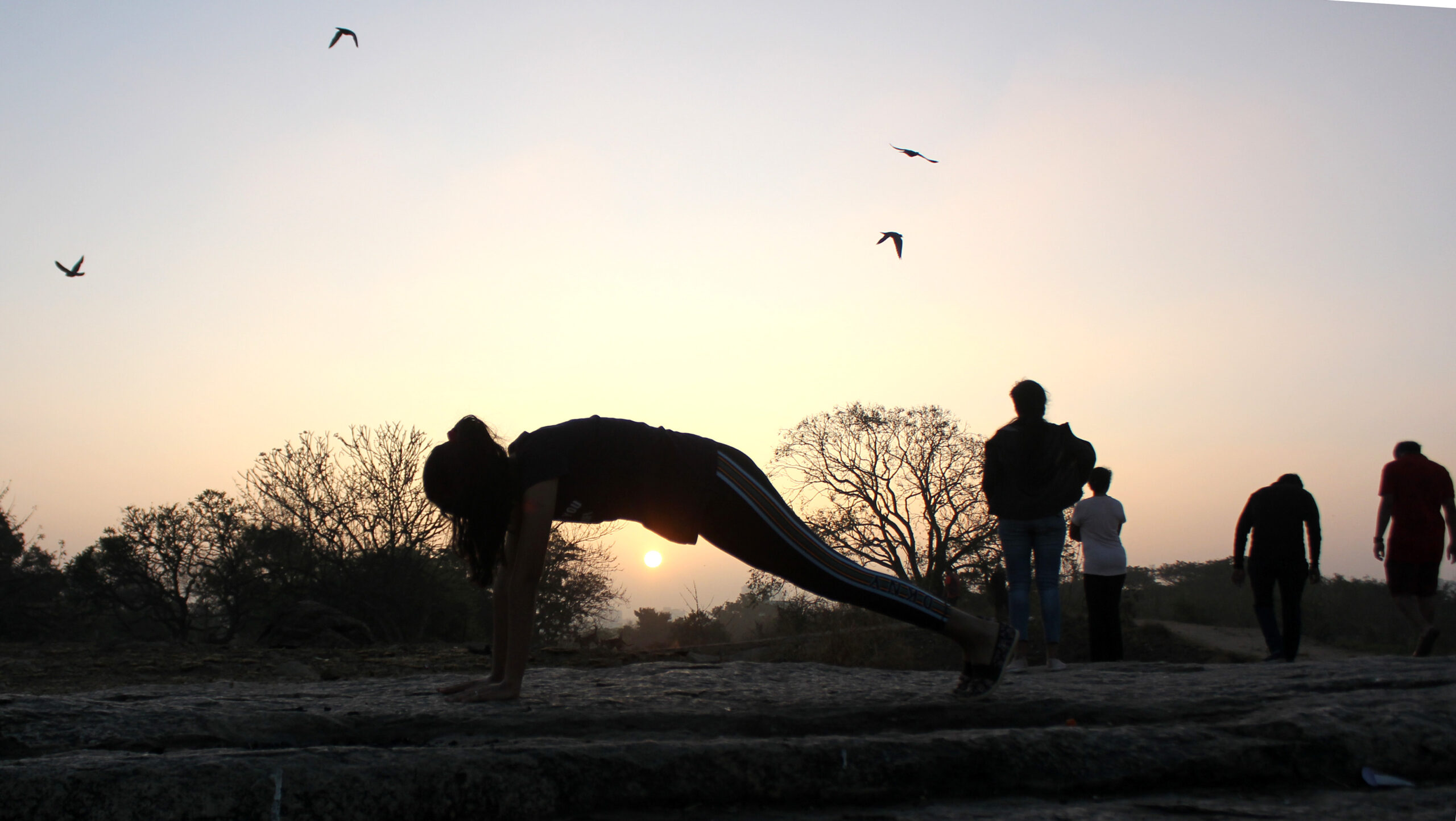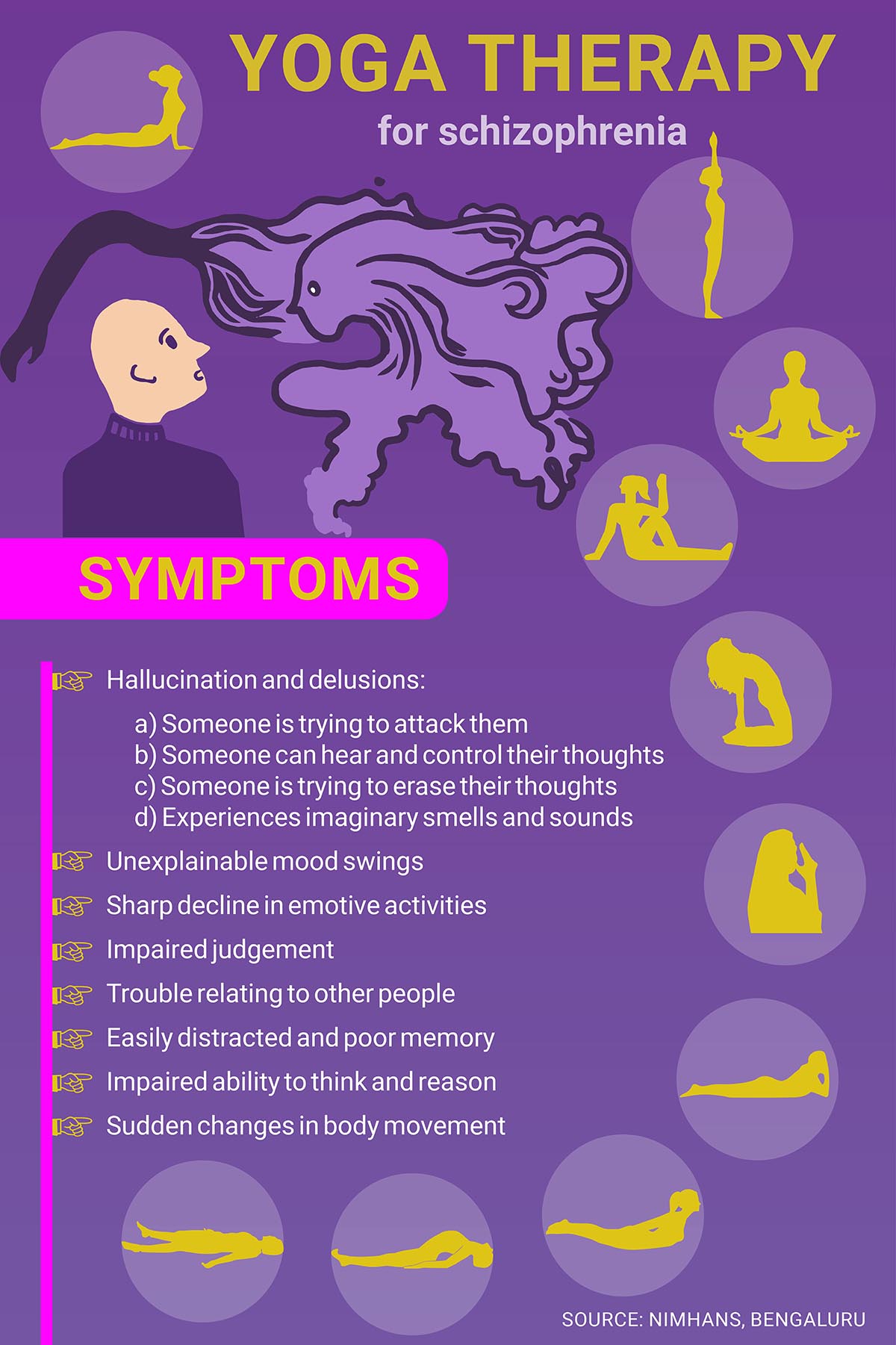
“When it comes to matters of the human mind, yoga begins where modern medicine takes a break.” This could well be the motto of the Department of Integrative Medicine at the National Institute of Mental Health and Neurosciences (Nimhans), the Bengaluru-based premier Indian institute that tackles issues related to the health and wellness of the human mind.
The department integrates traditional schools of medicine (like Ayurveda and yoga) along with the existing treatment protocols prescribed in psychiatry and neuroscience for ensuring the wellness of minds affected with conditions like schizophrenia, depression and other anxiety disorders.
As per data provided by Nimhans, 2,403 people registered for the ongoing yoga therapy for schizophrenia in the last two years alone (February 2020 to February 2022). Experts and researchers in psychiatry and neuroscience have already acknowledged the initial findings of multiple research studies on yoga and schizophrenia so far. However, they have also called for wider clinical trials and further studies to establish the efficacy and credibility of yoga as an intervention against schizophrenia on a global scale.
“In schizophrenia, there is a line-up of positive and negative symptoms,” Dr Shivarama Varambally, professor of psychiatry and head in-charge, Department of Integrative Medicine, Nimhans, told Happiest Health. “Modern medicine primarily focuses on positive symptoms like delusions, hallucinations, hearing voices, aggression, etc. But once these symptoms are subdued with medication, there is a need to address negative symptoms like lack of emotional empathy, reclusiveness [and] lack of productivity that are integral in everyday normal life. This is where the traditional approach of yoga kicks in.”
What is schizophrenia?
The exact trigger for schizophrenia is not yet fully understood but its onset is generally attributed to neurochemical anomalies in the brain cells that manipulate and control our emotional, cognitive and motor skills. It generally affects those within the age group of 15 to 44 years. Due to the hallucinatory and delusional nature of schizophrenia-induced psychosis, the affected individual could go into violent fits of aggression and paranoia, often posing a serious threat to themselves or those around them.
Dr Varambally said that adverse effect on neuroplasticity was one of the main factors responsible for schizophrenia. Neuroplasticity could be described as the capacity of our brain to adjust, evolve and adapt its neural functioning, and accordingly control and align the functioning of other organs and glands in an optimum manner. This ability becomes severely crippled and disoriented for people affected with schizophrenia.
Protein-based compounds — mainly dopamine and serotonin — that serve as neurotransmitter hormones in the human brain often slip into a hyperactive mode when someone suffers psychosis. Antipsychotic pills suppress and inhibit these neural hormones to calm down the individual. Scientifically speaking, this is where the scope of medical intervention in schizophrenia ends. The individual is expected to carry on with medication to keep their psychosis under control and deal with the residual or negative symptoms through external nonpharmacological interventions like support therapy, counselling, exercise and healthy lifestyle management.
“Nonpharmacological interventions like yoga are found to be beneficial in dealing with residual and negative symptoms and enhancing functionality of the individual to certain limits,” said Dr NN Raju, a psychiatrist based in Visakhapatnam and president of the Indian Psychiatric Society.
Dr Varambally said both in the neuroflogical and yoga-based interventions the key focus is on the hormonal interplay in the human brain that sends signals that define and control our emotions and motor skills. He said dopamine was responsible for invoking the feeling of motivation in us and deciding the appropriate action to be taken for achieving a goal within a deadline.
“Dopamine suppression through medication will definitely calm them down, but it will come with some emotional and motivational difficulties when they try to return to their professional and personal spaces,” he said.
Yin and yang of schizophrenia management
Experts involved in the yoga for schizophrenia maintain that traditional medicines and wellness techniques cannot upstage the advances made by psychiatry and modern neuroscience in the field.
“Proper medication is always the crux of treating schizophrenia along with psychosocial interventions,” said Dr Hemant Bhargav, assistant professor, Department of Integrative Medicine. “An antipsychotic drug course could be followed with yoga therapy to enhance the overall quality of life and everyday functionality of the affected individual. Yoga is to be used as a complementary therapy to enhance chances of total recovery.”
Dr Varambally along with experts from Nimhans carried out a randomized control trial in 2012 of yoga being an effective nonpharmacological intervention to tackle negative symptoms in people with schizophrenia after being stabilized with antipsychotic drug course. The research, which was approved and funded by the Government of India’s Department of Ayush, was published in the Indian Journal of Psychiatry in 2012. The subjects were selected from among outpatients at Nimhans and divided into three categories: one was taught yoga, another group was trained in regular workouts and a third waitlist group that was neither taught nor trained in yoga nor physical exercise.
After four months it was found that 35 per cent of those in the yoga group showed improvement in their negative symptoms and a drop in their social dysfunction score, as against less than 10 per cent in the remaining two study groups.
“The finding confirms the previous findings that yoga produces significant, albeit modest reductions in negative symptoms,” said the study. “This result should encourage adding of yoga as a complementary therapy for individuals with schizophrenia.”
Yoga, love hormone and schizophrenia
Antipsychotic treatment of those diagnosed with schizophrenia always works by suppressing dopamine and serotonin levels in the brain but it also often severely cripples their productivity and functionality. Therefore, psychiatric experts decided to explore the possibility of another hormone, the oxytocin, in the body to jumpstart the emotional and cognitive skill core of our brain.
“Oxytocin is called the love hormone that plays a major role in ensuring socially cognitive reactions (basically empathy) in human beings,” Dr Bhargav said. “It has been proven that oxytocin levels are low in people affected with schizophrenia and our research has proven that yoga could enhance oxytocin levels.”
Oxytocin is believed to hold the key to activating mirror neurons in our body. Mirror neurons, as the name suggests, are the neurotransmitters that helps us to connect with someone else’s emotional plight and respond accordingly.
“So, when we see someone crying, normally we are expected to voluntarily feel a sense of empathy,” Dr Varambally. “It is the expected social cognitive response. Oxytocin is the hormone that signals these appropriate reactions in us by triggering the mirror neurons. Oxytocin is also responsible for sudden bursts of love and emotional intimacy like the release of breast milk in lactating mothers when they are holding their newborns.”
In 2013 the department of psychiatry and neurochemistry at Nimhans carried out another study along with Morarji Desai Institute of Yoga, New Delhi, in which schizophrenic individuals stabilized on antipsychotic medications were given yoga therapy for over a month. It was found that oxytocin levels went up in blood samples collected from the subjects after the completion of the study.
“It has been proved that intranasal oxytocin supplementation could improve social cognitive skills in [people with schizophrenia],” the study said. “This is where yoga and controlled breathing has a direct impact on increasing the vagal activity by the stimulation of dermal or subdermal pressure receptors that are innervated by vagal afferent fibers, which ultimately project to the limbic system and has a direct or indirect connection with the neuroendocrine outputs.”
This conclusion basically means that yoga could effectively condition the human brain to trigger the release of hormones like oxytocin in a limited manner by influencing neuro-endocrinal output reactions through asanas and controlled-breathing techniques. The study was published in the Indian Journal of Psychiatry in July 2013.
Another major symptom of schizophrenia is the misinterpretation of facial emotions and exaggerated threat perception levels. This is one of the major factors that triggers psychosis in people with schizophrenia. Earlier, in 2010, experts from Nimhans had conducted another study that claimed that yoga could also be used as a complementary intervention to improve Facial Emotion Recognition Deficit (FERD), the key element in interpreting facial emotions.

Modalities of the yoga module for schizophrenia
The yoga module for schizophrenia consists of basic sets of exercise consisting of breathing techniques like tiger breathing, moon-pose breathing and a series of exercise sets consisting of jogging, bending and stretching along with sets of suryanamaskara (sun salutation) and shavasana (corpse pose). Initially the module is expected to be practised and done with expert supervision and guidance, but it was pointed out that later follow-ups could be done with minimum supervision.
“There is a shortage of trained personnel in assisting such individuals with rehabilitation,” Dr Varambally said. “The biggest advantage with yoga is that after the initial training, these individuals can practise the asanas in this module at home and ensure a certain level of wellness.”
The patients affected with schizophrenia being treated as inpatients and those arriving as outpatients at Nimhans could join the yoga therapy module. It is usually done after obtaining the consent of the consulting doctor and a basic health screening process. After about two weeks of yoga sessions, the participants are rated as per a Yoga Performance Assessment scale and then they are asked to practise at home and then come back for follow-ups to assess their overall improvement.
“We also provide a video clip of the individual performing yoga to be later used as a sort of self-tutorial manual at home,” Dr Bhargav said.
As per data provided from Nimhans, yoga therapy for various mental conditions were launched at the institute in 2009. The Department of Integrative medicine was constituted in 2019, after incorporating The Centre for Integrative Medicine and Research (CIMR) and Nimhans Integrated Centre for Yoga (NICY). Dr Bhargav said that apart from Karnataka many people from rural Tamil Nadu and Andhra Pradesh also availed yoga therapy for schizophrenia at Nimhans.
Birthday sari testimonial
According to Dr Bhargav, one of the biggest stories of yoga therapy at the department involves a 23-year-old youth from Bengaluru who suffered psychosis while he was at enrolled at an entrance coaching institute at Kota in Rajasthan in northwestern India. The initial symptoms went unnoticed and when the breakdown occurred the youth was initially brought back to Bengaluru and then treated with standard antipsychotic medication.
“His aggression came down but he became a recluse, refusing to talk or meet with anyone. He literally showed no interest in anything whatsoever. His parents were worried and decided to try yoga therapy for schizophrenia in 2017,” says Dr Bhargav.
Dr Bhargav said he started showing improvement within three months and has been doing regular follow-ups since then with steady improvement. His father, a state government employee, and mother were relieved with his gradual progress as he started to emotionally open up to them. They were convinced of his recovery on his mother’s birthday when he made it a point to go out and buy a sari as a gift for her.
“She [his mother] came to us after some days and was literally crying with joy, saying that she got her son back,” Dr Bhargav. “The boy had even made sure that the sari had some embroidery work on it in orange, his mother’s favourite colour. The fact that he remembered her birthday and took the initiative to go out and get her a sari as gift itself was an indicator of his progress.”
The youth, however, dropped his engineering Joint Entrance Examination plans and got enrolled for BSc Mathematics at a college in Bengaluru in 2018. He is now planning to do his master’s in MSc Biostatistics, a course offered at Nimhans itself.
More trials needed
Most of the research conducted on the application of yoga and even Ayurveda has a limited number of participants because the process is time-consuming and requires minute observation and periodical follow-ups. This often leads to people either refusing to give consent or dropping out midway. Still, globally renowned psychiatrists and neuro experts are closely monitoring the developments in yoga-based research and findings.
Asked about his opinion on the efficacy of yoga therapy for schizophrenia, Dr Matcheri Keshavan, head of psychiatry, Beth and Israel Deaconess Medical Center and Massachusetts Mental Health Center (MMHC), Harvard Medical School, told Happiest Health: “Yoga appears to be effective in treating negative symptoms from the few limited studies that have been done. This needs to be confirmed in larger independent clinical trials.”
He said that preliminary literature suggests effect of yoga on increasing oxytocin levels, but more research must be carried out on this and the link between oxytocin and negative symptoms of schizophrenia. “But it is clearly an area for future investigation,” Dr Keshavan said.
Dr Raju said yoga was one of the most effective methods for cognitive rehabilitation in numerous conditions and had lots of scope to evolve into a standardized intervention therapy with more research in the near future.
Rony George, director and founder, Chaitanya Institute for Mental Health, a residential psychiatric care home functioning in multiple Indian states (including Maharashtra, Goa and Kerala) and in Nepal said that they have yoga sessions regularly for the people with schizophrenia admitted at their centres to improve their social and cognitive skills. He said that after attending a few yoga sessions their inmates always make it a point to reach the yoga room on time with their mats without fail.
“We consider this itself as a great success,” said George. “Usually motivating people with schizophrenia to do something consistently as part of a routine is very difficult. The fact that they have started taking the initiative to regularly turn up for their sessions on time itself is proof that yoga is good for people with this condition.”
He said the best way to deal with the condition is to have modern medication as the main treatment course with yoga and other external interventions as complimentary therapy to improve their social and functional skills.

















